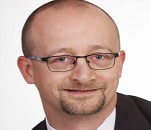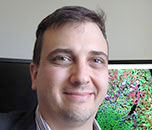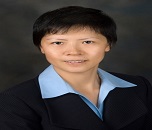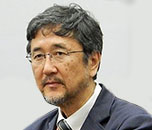Day 1 :
Keynote Forum
Christian Munzenmayer
Fraunhofer Institute for Integrated Circuits IIS, Germany
Keynote: An automated microscopy system for malaria diagnosis
Time : 9:00 AM

Biography:
Christian Munzenmayer has completed his Doctorate from the University of Koblenz-Landau in 2006. Since 2000, he is with the Fraunhofer Institute for Integrated Circuits IIS, Germany. His primary research interests center on image and texture analysis, automated microscopy and digital pathology. He is the Head of the research group Medical Image Processing and Manager of the business field Digital Pathology and Laboratory Diagnostics. He is the author and co-author of over 60 publications in scientific journals and proceeding volumes and has been Reviewer for Medical Engineering and Physics.
Abstract:
According to the World Health Organization (WHO), in 2015 there were an estimated 214 million cases of malaria (438000 deaths). Malaria is caused by parasites of five species, most importantly Plasmodium falciparum and P. vivax. Microscopic examinations, the recommended Gold standard are increasing (188 million microscopic examinations in 2012 globally). Therefore, Fraunhofer IIS is developing an automated microscopy system to support diagnosis of malaria. After automated detection of the smear with low magnification (2.5x) a configurable number of high-power fields (63x oil immersion) are acquired automatically. The detection algorithm starts with a custom threshold and morphologic detection step to extract possible plasmodia candidates. These candidate objects are afterwards automatically classified to separate non-plasmodia objects from plasmodia. For our system we evaluated two approaches. The first approach is based on a large variety of color and color texture features, automated feature selection and a support vector machine (SVM). The second approach is based on a deep learning scheme with convolutional neural networks (CNN). Both classifiers where trained with pre-annotated data from 44 slides-containing mostly P. falciparum and P. vivax cases (15.499 plasmodia, 39.374 non-plasmodia). The disjoint test set contains 37 slides with P. falciparum and P. vivax. With the SVM we reached an overall accuracy of 95.4% (92.7% sensitivity/95.5% specificity). The CNN performed slightly better with an accuracy of 96.7% (94.0% sensitivity/96.8% specificity). Based on these results our system helps to diagnose malaria infections in a less tedious, more secure and even more objective process.
Keynote Forum
Marcio Alvarez-Silva
Universidade Federal de Santa Catarina, SC, Brazil
Keynote: Advances in Bone Marrow Transplantation
Time : 10:00

Biography:
Graduated in Pharmacy at the Federal University of Rio de Janeiro, PhD in Sciences at the Federal University of Rio de Janeiro. Currently professor at the Federal University of Santa Catarina and coordinate the Laboratory of Stem Cell and Bioengineering, at the Department of Cell Biology, Embryology and Genetics. The Laboratory investigates the role of mesenchymal stem cells in the repair of neural injury as well as bone regeneration. Three-dimensional scaffolds for cultivation and maintenance of mesenchymal stem cells are one of the lines of research of the Research Group. The Laboratory investigates novel strategies for ex vivo expansion of hematopoietic stem cells. The amplification of hematopoietic stem cell can target allogeneic bone marrow transplantation for the treatment of hematopoietic malignancies.
Abstract:
Since the first successful bone marrow transplant on a patient with aplastic anemia in 1972 by Dr. E. Donnall Thomas and colleagues using a chemotherapeutic drug cocktail that included busulfan and cyclophosphamide as the preparatory regimen the technique has gained importance worldwide. It has become potentially curative for many neoplastic and nonmalignant disorders. Hematopoietic stem cell transplantation (HCT) using autologous or allogeneic hematopoietic progenitor cells has progressed and evolved because of the ability to apply new transplant concepts with this the therapy, such as umbilical cord blood transplantation (UCBT) and, more recently, haploidentical donor transplants. These advances have allowed for a broader range of donors. In addition, new regimens with high-dose cyclophosphamide have therapeutic benefits for disorders such as aplastic anemia and multiple sclerosis. On the other hand strategies to graft-versus-host disease (GVHD) prophylaxis, such as high-dose post-transplantation cyclophosphamid, is a viable alternative for patients lacking HLA-matched donors. Actually many strategies for GVHD prophylaxis are in course in many preclinical or clinical studies. Pitfalls, such as graft rejection, severe GVHD, and patient immune suppression are becoming less harmful as the advances in the field progresses. Further the scientific investigation is leading to the discovery of more therapeutically effective strategies for HCT as a more efficient therapy.
- Strategy and Technology
Digital Image Analysis
Telepathology
Digital Pathology Applications and Research Case Studies
Anatomic Pathology
Pathology informatics
Session Introduction
Paul Holvoet
Katholieke Universiteit Leuven, Belgium
Title: Mitochondrial stress in monocytes is reflected in microvesicles and associated with metabolic and coronary artery diseases

Biography:
Paul Holvoet is Professor in Biomedicine at the Department of Cardiovascular Sciences at the Catholic University of Leuven. His research focuses on the interaction between oxidative stress and inflammation in the pathogenesis of metabolic and cardiovascular diseases. He is a fellow of the European Society of Cardiology and the American Heart Association. He is first inventor on international patents related to oxidized LDL and gene signatures in monocytes and derived exosomes . He is a co-founder of TMTank, that has a reputation for DIWO (do it with others) allowing organizations to interconnect in a more efficient way.
Abstract:
Obesity’s negative impact on health is well-documented. Health consequences are categorized as being the result of either increased fat mass (which leads to osteoarthritis, obstructive sleep apnea, social stigma) or an increased number of fat cells (which contributes diabetes, cancer, cardiovascular diseases). Disease processes increasing risk in association with obesity are subclinical chronic low-grade inflammation and oxidative stress which are also involved in development of cardiovascular diseases. For example, recent data suggest that increased oxidative stress in adipose tissue is an early instigator of metabolic syndrome. Given the number of symptoms and risk factors which characterize metabolic syndrome, the variability in combinations of three out of five its components, and the variability in treatments and patient responses to treatment of those symptoms, there remains a need in the art for identifying patients who are at risk for developing metabolic syndrome, T2D, and/or cardiovascular diseases. In this study we discovered RNA expression patterns related to mitochondrial dysfunction and oxidative stress in monocytes which were associated with metabolic syndrome and T2D, and identified an at-risk population for new cardiovascular events in CAD patients. For the first time, we showed that signatures in monocyte-specific microvesicles reflects these in monocytes and have similar predictive properties. We also found that identified gene signatures were related to obesity and atherosclerosis in mice and pigs.
Francesca Vanzo
Consorzio Arsenal.IT, Italy
Title: What’s new in organ transplantation’s digital pathology: Review and highlights

Biography:
Francesca Vanzo has completed her Bachelor’s degree in Biomedical Engineering and Master’s degree in Bioengineering at University of Padua, Italy. She has a 10 years experience in eHealth interoperability IT projects in public administration, focusing also on radiology and digital pathology. Currently she works as a Project Engineer for the regional EHR project at Arsenal.IT.
Abstract:
Digital pathology represents one of the key factors in the future of organ transplantation. Our aim was to review the reliability of digital pathology and telepathology services. We searched scientific products in PubMed by coding key words as follows: Transplantation, digital pathology and telepathology, during the last 10 years. To each article has been given a score on eight different categories concerning digital pathology aspects in transplantation: Preparation, administrative, digital imaging creation, image analysis, image display, reliability study, General IT management and system integration. A total of 294 scientific articles have been found from 2006 to 2016. 25 articles have been analytically detailed. The remaining articles were not included as they could not be categorized. 19% of the articles evaluated image analysis algorithms applications or digital images. 15% of the articles focused the digital image creation. 8% of the articles provided a focus on the pre-analytical phase of slide preparation. 5% of the articles included administrative aspects. 4% of the articles described the IT management and 4% of the articles developed issues on system integration between Healthcare Information Systems. Main conclusions: Review of the Literature provide all information to build safe digital pathology and telepathology services during organ transplantation; most of studies verified the quality of image digital analysis, image display and digital imaging creation; major investments has to be posed to system integration systems and IT management or administrative staff in order to overcome unmet needs when building digital pathology services during organ transplantation.
Daniel Racoceanu
CNRS-INSERM, France
Title: Integrative digital pathology: Integrating phenotype with omics in future digital pathology

Biography:
Daniel Racoceanu is the Professor at Sorbonne University, University Pierre and Marie Curie and is the Director of the Cancer Theranostics research team of the Bioimaging Lab (CNRS-French National Center for Scientific Research, INSERM-French National Institute of Health and Medical Research). He is a Member of the Executive Board of the University Institute of Health Engineering of the Sorbonne University, Paris. He has participated to the creation of the International Research Unit IPAL (Image & Pervasive Access Lab) in Singapore, being the Director (between 2008 and 2014) of this joint research venture between the CNRS, NUS (National University of Singapore), A*STAR (Agency for Science, Technology and Research) and UPMC. Until 2015, he was an Adjunct Professor at NUS. He has published more than 30 papers in reputed journals and 100 papers conferences and also serving as an Editorial Board Member of reputable journals in the area of biomedical imaging and medical informatics
Abstract:
In line with recent advances in molecular imaging and genetics, keeping the microscopic modality at the core of future digital systems in pathology is fundamental to insure the acceptance of these new technologies, as well as a deeper systemic, structured comprehension of the pathologies. After all, at the scale of routine whole-slide imaging, the microscopic image represents a resolution at the scale of genomic information, enabling a naturally structured support for integrative digital pathology approaches. In order to accelerate and structure the integration of this heterogeneous information, a major effort is and will continue to be devoted to morphological micro-semiology (microscopic morphology semantics). The massive amount of visual data is challenging and represents an intrinsic characteristic to digital pathology. In parallel, progresses in cancer genomics, propelled by advances from Next Generation Sequencing, have enabled a very accurate molecular characterization of a patient’s tumor. Various large-scale projects (such as The Cancer Genome Atlas-TCGA or the International Cancer Genome Consortium) have initiated deepening the knowledge about the genomic landscape of alterations that can be linked to tumors. Indeed, the molecular characterization of a tumor has the potential to improve patient outcome in various ways. However, this information is mostly considered in an independent manner from the morphology of the population of tumor cells. Exploiting the richness conveyed by giving a spatial/morphological dimension together with the information on the molecular determinants of tumor growth could enable better-informed diagnostics. The scope of this insight is to support the emergence of an integrative framework able to leverage the morphological evidence coming from digital imaging, in order to guide the interpretation of omics data and the other way around, to help the pathologist performing its diagnostic on tumor grading after replacing it in its genetic/molecular context.
Tomoo Itoh
Kobe University Hospital, Japan
Title: Validation study of WSI based primary diagnosis by nine Japanese academic institutes

Biography:
Tomoo Ito has completed his PhD at Hokkaido University Graduate School of Medicine and at presently he is a Professor and Deputy Director of Diagnostic Pathology at Kobe University Hospital, Japan. He is a Board Certified Member of the Japanese Society of Pathology and Board Certified Member of the Japanese Society of Clinical Cytology. He has published more than 34 papers in reputed journals.
Abstract:
Background: Several reports demonstrate the availability for the primary diagnosis done by digitized slide glass specimen with Whole Slide Imaging (WSI). However, there has been no publication of the validation study from Japan, which is the requirement to obtain approval by Japanese Pharmaceuticals and Medical Devices Agency (PMDA).
Objective: To provide evidence of usability of WSI diagnosis for primary diagnosis compared to conventional glass slide diagnosis by multicenter consortium.
Method: 900 cases, 1070 slides available for histopathologic diagnosis by H&E observation in nine hospitals. The slide glasses were digitized and independent pathologists trained based on CAP guidelines had reviewed and made diagnosis for the digitized cases. Digitization was performed by 20x or 40x optical magnifications utilizing whole slide imaging scanner in each institute and observers reviewed conventional glass slides after more than 2 weeks of washout time interval. Discrepancies between microscope slide and WSI diagnosis were classified into 3 categories; concordance, major discrepancy (defined as ones associated with significant difference in clinical treatment) and minor discrepancy (defined as ones associated with no significant difference in clinical treatment). All pathologists were gathered to review cases with discrepant diagnosis and voted to decide category and cause of discrepancy.
Result: There were 9 diagnoses with major discrepancy (0.8%) and 38 minor diagnoses with discrepancy (3.6%) between WSI and microscopic diagnosis. Eight among 9 diagnoses with major discrepancy were judged as proper to the diagnoses based on conventional microscopic observation. There was no association between level of discrepancy and categories of organ, collecting method or digitized optical magnification. Major discrepancy rates in all institutes were almost similar ranged from 0% to 3.0%.
Conclusion: Our results indicate the safety and efficacy of WSI based primary diagnosis for cases with biopsy and small surgery in Japan. We also emphasize the need of intense training specified for digital pathology diagnosis before its recruitment to the routine clinic.
Ichiro Mori
International University of Health and Welfare, Japan
Title: Trials of international WSI telepathology consultation with eastern Asian countries

Biography:
Ichiro Mori has completed his PhD from Gunma University and Postdoctoral studies from Tokai University School of Medicine. He is a Professor of Pathology, Mita Hospital, International University of Health and Welfare. He has published more than 25 papers in reputed journals.
Abstract:
Using digital pathology, we made several trials of international WSI (Whole Slide Imaging) telepathology consultation with eastern Asian countries. In eastern Asia, there is big difference of infrastructures between countries. This work is supported by Japanese Ministry of Economy, Trade and Industry. We set up a consortium with Hamamatsu photonics for WSI scanner, Sakura Finetek for pathology equipment, Toshiba Medical Systems for radiological images and Panasonic System Solutions for Network and TV conference system. We mainly tried real time online teleconference using WSI images. In particular, we prepared interesting cases prior the teleconference, scan to WSI and stored in the server. Attended pathologists observed these WSIs before the teleconference, make diagnosis and leave the diagnosis document to the server. One of our members visited to their hospitals and he moderate the teleconference. Discussion through teleconference system was made in English. The WSI images maintained adequate quality for pathology diagnosis even looked from abroad. The diagnoses matched well between hospitals. The response of WSI viewer depended on the web speed. Infrastructure including Web speed was differed between countries. When we shared band width to the teleconference system or radiological images sent in the background, the response deteriorates and was not good enough for diagnosis. It was confirmed that there is no problem in international remote diagnosis using WSI. The international WSI telepathology diagnosis is now in a stage of practical use. Remaining issues are language, quality of glass slides, difference in diagnosis criteria, economical and responsibility issues, etc. Finally, based on these experiments, we came to agreement with Vietnamese Government and decide to open a multiphasic health check facility in Ho-Chi-Minh city, Vietnam.
Manuel F M Costa
Universidade do Minho, Portugal
Title: Application of neural networks to the classification of photorefraction images

Biography:
Manuel F M Costa hold a PhD degree in Physics from the University of Minho, Portugal, where he teaching since 1985 at its Physics Department and performing applied research in optical metrology, applied optics, thin films and nanoscience, optometry and science education and literacy. He has presented over 300 communications in international meetings and published around the same number of scientific papers, monographs and books. He is an Editor or Member of the Editorial Board of several scientific and educational international journals and Chairperson on 19 international conferences.
Abstract:
Neural networks are successfully being used for many years in a large number of fields of science and technology but also in medicine and virtually all fields of knowledge. Even in simple non advanced ways the results of the application of neural networks to a number of problems give good and reliable results comparable and most often better than traditional methods. In the work herein we report an application to an optometry problem: The automated classification of digital photorefraction images obtain to characterize the refractive status of patients, mostly young children. The importance of an early evaluation of the condition of the visual system of infants is long time recognized. Non corrected optometric or ophthalmologic problems may lead to major vision and developmental non-reversible limitations in the future. Among the objective methods of refraction photorefractive techniques are specifically designed for screening young children. Over the years a number of photorefraction systems with different grades of complexity and automation were developed. One critical problem that needs to deal with in any approach of these systems is the interpretation and classification of the photorefraction images.

Biography:
Elizabeth C M de Lange has obtained her PhD from Leiden University in 1993 and was tenured in 2004. She is the Head of the Translational Pharmacology Group at Leiden Academic Center for Drug Research (LACDR). Her ultimate aim is to aid in the prediction of the dose-response relationship of CNS drugs in the clinical setting, on the basis of preclinical data (translational research). Her research involves the identification and characterization of the rate and extent of key factors in the dose-response relationship of CNS drugs in health and CNS disorders. It involves the use of advanced preclinical research (e.g.m including microdialysis, EEG monitoring, PET scanning) and advanced pharmacometrics (Systems Pharmacology). She has published more than 100 papers and book chapters and she is a frequently invited lecturer. Furthermore, she is a Member of the Editorial Board of FBCNS, co-founded and (co-) chaired several of the International Symposia on Microdialysis in Drug R&D. She is an AAPS Fellow since 2013. Her company In Focus provides courses, training and advice on microdialysis, pharmacokinetics, BBB transport and CNS target site distribution and effects and systems pharmacology.
Abstract:
Changes in blood-brain barrier (BBB) functionality have been implicated in Parkinson's disease. This study aimed to investigate BBB transport of L-DOPA transport in conjunction with its intra-brain conversion, in both control and diseased cerebral hemispheres in the unilateral rat rotenone model of Parkinson's disease. In Lewis rats, at 14 days after unilateral infusion of rotenone into the medial forebrain bundle, L-DOPA was administered intravenously (10, 25 or 50 mg/kg). Serial blood samples and brain striatal microdialysates were analyzed for L-DOPA and the dopamine metabolites DOPAC and HVA. Ex vivo brain tissue was analyzed for changes in tyrosine hydroxylase staining as a biomarker for Parkinson's disease severity. Data were analyzed by population pharmacokinetic analysis (NONMEM) to compare BBB transport of L-DOPA in conjunction with the conversion of L-DOPA into DOPAC and HVA, in control and diseased cerebral hemisphere. Plasma pharmacokinetics of L-DOPA could be described by a 3-compartmental model. In rotenone responders (71%), no difference in L-DOPA BBB transport was found between diseased and control cerebral hemisphere. However, in the diseased compared with the control side, basal microdialysate levels of DOPAC and HVA were substantially lower, whereas following L-DOPA administration their elimination rates were higher. Parkinson's disease-like pathology indicated by a huge reduction of tyrosine hydroxylase as well as by substantially reduced levels and higher elimination rates of DOPAC and HVA, does not result in changes in BBB transport of L-DOPA. Taking the results of this study and that of previous ones, it can be concluded that changes in BBB functionality are not a specific characteristic of Parkinson's disease and cannot account for the decreased benefit of L-DOPA at later stages of Parkinson's disease.
Michael Grunkin
CEO of Visiopharm, Denmark
Title: A business case for quantitative digital pathology

Biography:
Michael Grunkin is the CEO of Visiopharm A/S, Denmark. He has obtained his PhD in Image Analysis and Spatial Statistics from the Technical University of Denmark in 1993. His Post-doctoral work at Massachusetts Institute of Technology and Harvard Medical School was focused on the application of image analysis for medical devices. From 1996, he was the technical Founder of two Danish medical device companies based on image analysis as the platform technology. In 2001, he has Co-Founded Visiopharm A/S, which is a quantitative digital pathology company with focus on cancer research, diagnostics and the general standardization of tissue data.
Abstract:
Pathologists all over the developed world are increasingly challenged both by the growing diagnostic volume and the complexity of cases to be read. These challenges are further amplified by shrinking budgets and the competitive pressures from new diagnostic modalities such as gene expression assays and next-generation sequencing. The widely published lack of data quality in terms of reproducibility, sensitivity and specificity of manual readings has probably contributed to generating a growing demand for new diagnostic modalities and probably also contributed to the growing pressure on budgets. Image analysis has the potential to impact significantly on data quality. In order to have such an impact, a number of essential technical solution components are required for mitigating several error sources on the journey from biopsy to diagnostic, prognostic or predictive tissue data. Solution requirements include: Correct and verifiable identification of invasive tumor cells, excluding stromal and pre-invasive cells, handling of tumor heterogeneity and identification of hot-spots, standardized quantification of sub-cellular biomarkers and gene probe assays in tumor cells and assessment of staining quality, which at least is possible for immunohistochemical markers. In studies, evidence is found suggesting that these four solution components have a profound impact on data quality. These studies further indicate that the combination of immunohistochemistry with image analysis controls are capable of yielding data of a quality and clinical utility which is at least comparable to alternative and competing methods but at a significantly lower cost. The underlying technical solution components and clinical study results are presented.
Gloria Bueno
Universidad de Castilla-La Mancha, Spain
Title: AIDPATH: The 1st european project for academia and industrial collaboration for digital pathology

Biography:
Gloria Bueno is a Professor and researcher at the School of Industrial EngineersUCLM in Ciudad Real, Spain since 2002.She did her PhD in Computer Vision at Coventry University in 1998. She conducted research in different centers, such as: center for Studies in Technical Research of Guipuzcoa - San Sebastian & Louis Pasteur (E), Centre National de Recherche Scientifique the Civil Hopitaux Telecommunication School, University, Strasbourg (FR) And Gilbert Gilkes &Gordon Technology, Kendal (UK). She directs different projects of national and European research biomedical image processing. Her current interests are: signal and image processing, modelling and artificial intelligence.
Abstract:
Advances in digital pathology are generating huge volumes of whole slide and tissue microarray images which are providing new insights into the causes of most devastating diseases. They also present tremendous opportunities for developing and evaluating new and more effective treatments that may revolutionize the care of patients with cancers and other diseases. The challenge is to exploit the new and emerging digital pathology technologies effectively in order to process and model all the heterogeneous tissue-derived data. This requires joint research projects and collaborative programmes between academia and industry, which will help developing efficient and innovative products to fulfil the needs of digital pathology. This is the goal of the AIDPATH project: AIDPATH is composed by 4 companies (Leica, Astrazeneca, Barco and TissueGnostics), 3 hospitals and 5 research institutions in Europe and funded by Marie Curie Actions FP7 EC-612471 during 4 years. AIDPATH facilitates the development of digital pathology by producing new products and research results tailored to fulfil their needs. The work done and the results obtained for different applications in breast and colorectal cancer as well as in nephropathology will be presented in this conference.
Tomoo Itoh
Kobe University Hospital, Japan
Title: Validation study of WSI based primary diagnosis by nine Japanese academic institutes

Biography:
Tomoo Itoh has completed his PhD at Hokkaido University Graduate School of Medicine and presently he is a Professor and Deputy Director of Diagnostic Pathology at Kobe University Hospital, Japan. He is a board certified Member of the Japanese Society of Pathology and board certified Member of the Japanese Society of Clinical Cytology. He has published more than 34 papers in reputed journals.
Abstract:
Background: Several reports demonstrate the availability for the primary diagnosis done by digitized slide glass specimen with Whole Slide Imaging (WSI). However, there has been no publication of the validation study from Japan, which is the requirement to obtain approval by Japanese Pharmaceuticals and Medical Devices Agency (PMDA).
Objective: To provide evidence of usability of WSI diagnosis for primary diagnosis compared to conventional glass slide diagnosis by multicenter consortium.
Method: 900 cases, 1070 slides available for histopathologic diagnosis by H&E observation in nine hospitals. The slide glasses were digitized and independent pathologists trained based on CAP guidelines had reviewed and made diagnosis for the digitized cases. Digitization was performed by 20x or 40x optical magnifications utilizing whole slide imaging scanner in each institute and observers reviewed conventional glass slides after more than 2 weeks of washout time interval. Discrepancies between microscope slide and WSI diagnosis were classified into 3 categories; concordance, major discrepancy (defined as ones associated with significant difference in clinical treatment) and minor discrepancy (defined as ones associated with no significant difference in clinical treatment). All pathologists were gathered to review cases with discrepant diagnosis and voted to decide category and cause of discrepancy.
Result: There were 9 diagnoses with major discrepancy (0.8%) and 38 minor diagnoses with discrepancy (3.6%) between WSI and microscopic diagnosis. Eight among 9 diagnoses with major discrepancy were judged as proper to the diagnoses based on conventional microscopic observation. There was no association between level of discrepancy and categories of organ, collecting method or digitized optical magnification. Major discrepancy rates in all institutes were almost similar ranged from 0% to 3.0%.
Conclusion: Our results indicate the safety and efficacy of WSI based primary diagnosis for cases with biopsy and small surgery in Japan. We also emphasize the need of intense training specified for digital pathology diagnosis before its recruitment to the routine clinic.
Susan I Anderson
University of Nottingham, UK
Title: Digital microscopy and pathology in the education of medical students and as an open access training tool for specialist trainees

Biography:
Susan I Anderson has completed her PhD at the University of Notttingham in 2001 and has worked there since; initially as Director of the Advanced Microscopy Facility and then as Academic Lead for Pathology before becoming the Director of Undergraduate Studies in the School of Medicine. She is also the Head of Education and Outreach for the Royal Microscopical Society, leading a successful schools science outreach program and professional Diploma qualification as well as leading the public engagement activities of the society. She is also the Deputy Director of the BBSRC Doctoral Training Program at the University of Nottingham. She has research interests in bone metabolism and medical education. She has introduced the use of virtual microscopy and pathology to over 1000 students at the University of Nottingham and is currently writing a textbook on Essential Clinical Histology
Abstract:
The University of Nottingham has been using a virtual microscope for the delivery of pathology teaching on the medical, science and veterinary programs for several years. Evaluation of student feedback has revealed that the introduction of online, e-workbooks for tailored learning has been a key to the engagement and success of this technology in the Medical School. Student engagement and understanding has been improved and many students chose the histopathology specialist module in following years as a consequence. To further develop this as a method of e-learning, this teaching was incorporated into case studies for medical students, supported by a teaching development grant from the HEA. This has led to the development of an integrated teaching package linking normal histology and pathology to clinical scenarios and has engaged students in the production of these. Currently this format is being developed, in collaboration with Prof Emad Rakha and the Nottingham Breast Cancer group to prepare an open access, online training tool for histopathologists working in the field of breast cancer.
Jan Lukas Robertus
Royal Brompton and Harefield NHS Foundation trust, UK
Title: Strategy, development and application of digital pathology in a tertiary referral centre. The Royal Brompton and Harefield NHS Foundation Trust experience

Biography:
Jan Lukas Robertus MD, PhD, was appointed as a Senior Consultant Cardiothoracic Pathologist at Royal Brompton and Harefield NHS Foundation trust in February 2015. He previously worked as a Senior Consultant Cardiothoracic Pathologist at the Erasmus Medical Center, Rotterdam, The Netherlands. He provides a full range of diagnostic cardiothoracic pathology. He is lead pathologist for cardiovascular pathology, molecular and digital pathology and co-lead for cardiac and pulmonary transplantation. He is also co-lead for the Brompton Cardiac Morphology Unit and is member of the Brompton Cardiac Morphology Steering Committee. He is Honorary Senior Clinical Lecturer at the National Heart and Lung Institute, Faculty of Medicine, Imperial College London. His main research interests are thoracic oncology and cardiomyopathies.
Abstract:
Digital pathology is fast becoming a mainstay care pathway in routine diagnostics. It is transforming the way most hospitals approach both workflow and communication with other hospitals and is accelerating developments in the field of computational pathology, specifically with regards to the development of diagnostic tools. The Royal Brompton and Harefield Trust is a tertiary referral centre for Cardiothoracic Pathology and Heart and Lung Transplant Pathology. The Royal Brompton and Harefield Trust currently implements cross site digital pathology reporting for frozen sections and biopsies and is developing applications to expand the role of digitization of pathology at the Royal Brompton and Harefield Hospitals. Particularly for tertiary referral centres, application of digital imaging of slides benefits the systematic organisation of referral cases from other hospitals. This impacts on cost and efficiency in reporting. In order to utilize digital pathways. The referral centres and referring hospitals must have a committed access to an integrated framework in which digital imaging and reporting is facilitated. Developing such a framework can be costly and difficult in the current financial climate but also an arduous undertaking due to the complexity and heterogeneity of the various information management systems in place in different hospitals.
The importance of the role of digitization of archival material is of considerable relevance for tertiary referral centres such as The Royal Brompton and Harefield Trust. Traditional glass slide archives contain a plethora of novel and unexplored information. Digitalisation of glass archives, in parallel with the development of computation pathology, will allow for the unlocking and mining of this information. Given the fact that tertiary referral centres develop an often unique archive due to the nature of their specialized diagnostic workload, digitization of these specialized archives presents an opportunity to unlock the unique information contained within these archives and will help develop both novel image analytics algorithms and facilitate big data exploration.
Christian Munzenmayer
Fraunhofer Institute for Integrated Circuits IIS, Germany
Title: A web-based platform for education and quality control in cell morphology

Biography:
Christian Munzenmayer has completed his Doctorate from the University of Koblenz-Landau in 2006. Since 2000, he is with the Fraunhofer Institute for Integrated Circuits IIS, Germany. His primary research interests center on image and texture analysis, automated microscopy and digital pathology. He is the Head of the research group Medical Image Processing and Manager of the business field Digital Pathology and Laboratory Diagnostics. He is the author and co-author of over 60 publications in scientific journals and proceeding volumes and has been Reviewer for Medical Engineering and Physics.
Abstract:
The morphological differentiation of cells is a challenging task for which experience and continuous qualification over many years is needed. In the field of diagnostics of variations in blood and hematopoietic organs the qualification of health personnel is of particular importance. For this reason an interactively usable knowledge and qualification platform for professionals in hematology in the area of cell morphology has been developed. The HemaWeb platform covers significant aspects of knowledge transfer, knowledge development and knowledge assurance and provides professional exchange with tutorial support and certified examinations. Fundamental information about cell morphology is contained in a case database and in a cell dictionary. Interactive test assignments provide the opportunity to check this basic knowledge. Knowledge Transfer from experts to platform users is supported by interactive discussion of clinical cases in webinars and case conferences through a discussion platform. The core element of the platform is a module for internal and external quality control (inter-laboratory tests) by means of virtual microscopy. Digitized samples are pre-annotated by a clinical expert as supervisor of the test. Participating laboratories can access and navigate slides, enter their annotations and receive automated reports on their performance. The platform has been evaluated in a several pilot studies with hematology laboratories in Germany. It provides access to high-quality slides and flexible, extra-occupational education without the obligation to be present. Improved education and training possibilities can be realized and cost-efficient execution of inter-laboratory tests with a higher grade of comparability are possible.
Lee Cooper
Emory University School of Medicine
Title: HistomicsTK: Developing an open-sourced platform for integrated histopathology analysis

Biography:
Lee Cooper is an Assistant Professor with joint appointments in Biomedical Informatics and Biomedical Engineering at Emory University and Georgia Tech. He has received his PhD degree in Electrical Engineering from Ohio State University in 2009 and then joined Emory University; where he currently leads the Cancer Data Science lab. His research investigates computational methods for the analysis and integration of digital pathology, genomic and clinical data with the goals of improving prognostic accuracy and disease classification.
Abstract:
Open-sourced software is an important resource for research communities, providing transparency, reproducibility and enabling broad engagement among researchers to understand and build upon the communities’ work. While mature open-sourced image analysis tools are commonplace in the radiology domain, the digital pathology domain has relatively few open source tools for histopathology image analysis. This talk will discuss ongoing efforts by Emory and Kitware, Inc. to develop HistomicsTK, an open source platform for histopathology image analysis. HistomicsTK enables users to analyze large collections of whole-slide images, providing algorithms for common image analysis tasks including segmentation, feature extraction and classification. It provides infrastructure for the parallel execution of image analysis pipelines and enables algorithm/pipeline portability and easy deployment using containerization technology and network-based access to computational capabilities through REST interfaces. Case studies using HistomicsTK and its precursor tools will be presented including systems for interactive classification, nuclear morphometrics and immunohistochemical quantification. Using data from The Cancer Genome Atlas we will demonstrate how HistomicsTK can used to analyze multifaceted datasets containing digital pathology images and comprehensive genomic and clinical characterizations of cancers to explore prognostic imaging biomarkers and to investigate fundamental disease processes like angiogenesis and lymphocytic infiltration.
David A Gutman
Emory University School of Medicine, USA
Title: The cancer digital slide archive (CDSA): A web based resource linking pathology, radiology and genomics

Biography:
David A Gutman has received his MD/PhD from Emory University and then completed a Psychiatry Residency. He has published over 75 papers and has a broad range of interests in the digital imaging (radiology and pathology) and clinical informatics. He is currently an Assistant Professor of Neurology, Psychiatry & Biomedical Informatics and is also a Staff Physician at the Atlanta VA.
Abstract:
The Cancer Genome Atlas (TCGA) is an NCI funded project integrating clinical, histopathological, molecular (mRNA/miRNA, protein, copy number, etc) and metadata for over 25 different cancer types. The overall goal is to harness large data sets to discover insights in cancer progression. Several recent TCGA studies have illustrated important relationships between morphology observed in whole-slide images, clinical data and genetic events and therefore the ability to link these data sources over hundreds of patients could potentially lead to a greater insight in cancer progression. However, the integration and visualization is a common challenge in biomedical informatics and better tools are needed to combine the vast and disparate data types. Our group has developed a number of web-based tools to support the federation, visualization and analysis of both pathology and radiology imaging data. The CDSA houses over 25000 digital pathology images as well as integrated tools to view related metadata, as well as for image markup and data analysis. A brief overview of some of the capabilities and data available in this public resource will be discussed. In addition, we will review some of the open-source tools used to power this archive. Finally, some of the science that this technology has enabled will be reviewed.
Hong Amy Zhang
University of Texas MD Anderson Cancer Center, USA
Title: Biomarkers for breast cancer: Where we are now

Biography:
Hong Amy Zhang is currently an Associate Professor in the Department of Pathology and Translational Molecular Pathology in University of Texas-MD Anderson Cancer Center in Houston, TX, specializing in Breast Cancer Pathology. Prior to joining UT-MDACC, she was an Assistant Professor in the Department of Pathology in the Baylor College of Medicine from 2006 to 2009. She is an American board certified practicing Pathologist since 2003. She has expertise in diagnosing breast cancers and the interpretation of the biomarkers relevant to breast cancers for patient care. She is also actively supervising research scientists and trainees on translational and laboratory research, focusing on the characterization of tumor markers significant for breast tumorigenesis and the development of small molecule inhibitors and potential novel molecular targets for breast cancer treatment.
Abstract:
Breast cancer is one of the leading causes of cancer death in women, but there has been a sustained decline in mortality rates over the last decades despite the increasing incidence of breast cancer. The effective adjuvant systemic treatment is one of the major contributors to this recent development. Breast cancer treatment has experienced several changes in the past decades due to the discovery of specific prognostic and predictive biomarkers that enable targeted therapies. In addition to the classical clinical prognostic factors of breast cancer, established biomarkers such as estrogen receptor and progesterone receptor have played a significant role in the selection of patients benefiting from endocrine therapy. More recently, the human epidermal growth factor receptor 2 (HER2) has been validated to be not only a prognostic factor, but also a predictor of response to HER2 targeting therapy. The marker of proliferation Ki67 has recently emerged as an important marker due to several applications in neoadjuvant therapy in addition to its moderate prognostic value. In the past two decades, the human genome project and the development of high-throughput technologies prompts the rapid emerging multi-gene signature for certain tumors with characteristic clinical behaviors to novel therapy strategies. The gene expression profiling of tumors allows the measurement of thousands of mRNA transcripts in one single experiment using DNA microarrays. In combination of rapidly developing bioinformatics technology, the novel multi-gene signatures play an increasingly important role in patient care. It is imperative for the practicing pathologists to keep updated knowledge of new development of biomarkers, the biological scenario of the development and their potential clinical applications.

Biography:
Michael Grunkin is the CEO of Visiopharm A/S, Denmark. He has obtained his PhD in Image Analysis and Spatial Statistics from the Technical University of Denmark in 1993. His Post-doctoral work at Massachusetts Institute of Technology and Harvard Medical School was focused on the application of image analysis for medical devices. From 1996, he was the technical Founder of two Danish medical device companies based on image analysis as the platform technology. In 2001, he has Co-Founded Visiopharm A/S, which is a quantitative digital pathology company with focus on cancer research, diagnostics and the general standardization of tissue data.
Abstract:
Pathologists all over the developed world are increasingly challenged both by the growing diagnostic volume and the complexity of cases to be read. These challenges are further amplified by shrinking budgets and the competitive pressures from new diagnostic modalities such as gene expression assays and next-generation sequencing. The widely published lack of data quality in terms of reproducibility, sensitivity and specificity of manual readings has probably contributed to generating a growing demand for new diagnostic modalities and probably also contributed to the growing pressure on budgets. Image analysis has the potential to impact significantly on data quality. In order to have such an impact, a number of essential technical solution components are required for mitigating several error sources on the journey from biopsy to diagnostic, prognostic or predictive tissue data. Solution requirements include: Correct and verifiable identification of invasive tumor cells, excluding stromal and pre-invasive cells, handling of tumor heterogeneity and identification of hot-spots, standardized quantification of sub-cellular biomarkers and gene probe assays in tumor cells and assessment of staining quality, which at least is possible for immunohistochemical markers. In studies, evidence is found suggesting that these four solution components have a profound impact on data quality. These studies further indicate that the combination of immunohistochemistry with image analysis controls are capable of yielding data of a quality and clinical utility which is at least comparable to alternative and competing methods but at a significantly lower cost. The underlying technical solution components and clinical study results are presented.
Ichiro Mori
International University of Health and Welfare, Japan
Title: Trials of international WSI telepathology consultation with eastern Asian countries

Biography:
Ichiro Mori has completed his PhD from Gunma University and Postdoctoral studies from Tokai University School of Medicine. He is a Professor of Pathology, Mita Hospital, International University of Health and Welfare. He has published more than 25 papers in reputed journals.
Abstract:
Using digital pathology, we made several trials of international WSI (Whole Slide Imaging) telepathology consultation with eastern Asian countries. In eastern Asia, there is big difference of infrastructures between countries. This work is supported by Japanese Ministry of Economy, Trade and Industry. We set up a consortium with Hamamatsu photonics for WSI scanner, Sakura Finetek for pathology equipment, Toshiba Medical Systems for radiological images and Panasonic System Solutions for Network and TV conference system. We mainly tried real time online teleconference using WSI images. In particular, we prepared interesting cases prior the teleconference, scan to WSI and stored in the server. Attended pathologists observed these WSIs before the teleconference, make diagnosis and leave the diagnosis document to the server. One of our members visited to their hospitals and he moderate the teleconference. Discussion through teleconference system was made in English. The WSI images maintained adequate quality for pathology diagnosis even looked from abroad. The diagnoses matched well between hospitals. The response of WSI viewer depended on the web speed. Infrastructure including Web speed was differed between countries. When we shared band width to the teleconference system or radiological images sent in the background, the response deteriorates and was not good enough for diagnosis. It was confirmed that there is no problem in international remote diagnosis using WSI. The international WSI telepathology diagnosis is now in a stage of practical use. Remaining issues are language, quality of glass slides, difference in diagnosis criteria, economical and responsibility issues, etc. Finally, based on these experiments, we came to agreement with Vietnamese Government and decide to open a multiphasic health check facility in Ho-Chi-Minh city, Vietnam.
